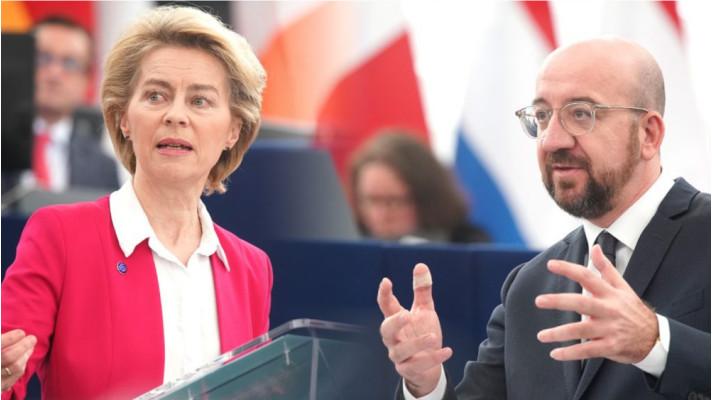EU's 2030 emissions target will not save the climate
EU leaders celebrated an agreement to slash emissions by 55% over the next decade. But the target is not enough to avoid catastrophic heating and its reliance on hydrogen and accounting tricks is problematic, environmental groups said.
In a long-awaited meeting in Brussels last week, national governments agreed to support the European Commission's proposal for a net 55% target for the reduction of greenhouse gas emissions by 2030.
The target, which represents an increase from the previously proposed 40%, was hailed by EU leaders as a historic moment for Europe. Former Belgian Prime Minister and current President of the European Council Charles Michels welcomed the move stating that the bloc "is a leader in the fight against climate change."
However, it is a far cry from what Europe needs to prevent the worst consequences of climate breakdown. Barbara Mariani, a senior policy officer at the European Environmental Bureau (EEB), said that target is "no reason to celebrate" and argued that it is way below the 65% decrease that science requires.
"Governments will no doubt call it historic, but the evidence shows that this deal is only a small improvement on the emission cuts the EU is already expected to achieve," said Sebastian Mang, a climate policy adviser at Greenpeace EU.
NGOs also criticised the Council's controversial decision to count international carbon offsets towards the final target. This would allow the EU to consider the contribution of environmental projects such as tree planting in developing countries as a way of reaching its own climate goals - something green groups dismissed as nothing short of an accounting trick, meaning that the EU would only need to achieve as little as a 50.5% cut in real emissions.
According to the United Nations, annual global emissions must be cut by at least 7.6% annually until 2030 to reach the 1.5°C target agreed as part of the Paris Agreement. This requires a 65% emissions reduction across the EU, as originally proposed in a report by Swedish MEP Jytte Guteland.
Recently, a study by the EEB and CAN Europe - in cooperation with academia and grid operators - also showed that should an intermediate target be increased to 65%, the EU could reach climate neutrality in 2040 - that's 10 years earlier than currently planned.
The European Council is now expected to negotiate its position with the European Parliament, which voted in October to increase the 2030 target to 60%. A final decision is expected to be announced in the first quarter of 2021.
What role for hydrogen?
The EU's intermediate climate target was not the only issue on the table. Governments also gave their approval to measures and investments to help scale up the production of hydrogen, as proposed by the European Commission earlier this year.
NGOs view the role of hydrogen in the energy transition with caution. Only if produced sustainably using renewable electricity can the gas be defined as clean, Mariani said.
The problem is that hydrogen today is mostly produced from fossil fuels, including gas and coal used to generate electricity or as feedstock. This process, which the strategy refers to as 'low-carbon', is responsible for an estimated 70 to 100 million tonnes of carbon dioxide emissions a year in Europe alone.
During their meeting last week, EU leaders agreed that "emphasis should be given to hydrogen from renewable sources". However, they also concluded that new gas infrastructure will be need to produce fossil-based hydrogen.
"There is a risk that a huge amount of EU money in the upcoming Recovery Fund will be spent on hydrogen produced through the use of gas," said Mariani. "This will inevitably lock our economies into burning fossil fuels for at least the next two decades."
The Council also missed an opportunity to stand against the use of renewable hydrogen for domestic and industrial heating.
"Because of current production costs and limited availability, renewable hydrogen should not be used to heat our homes, where other sustainable solutions already exist," Mariani said.
Experts argue that a cost-effective role for renewable hydrogen would be in the decarbonisation of Europe's most energy-intensive industries and transport - particularly steel and cement manufacturing as well as shipping and aviation - where electrification may be more challenging.
Zdroj: European Environmental Bureau
